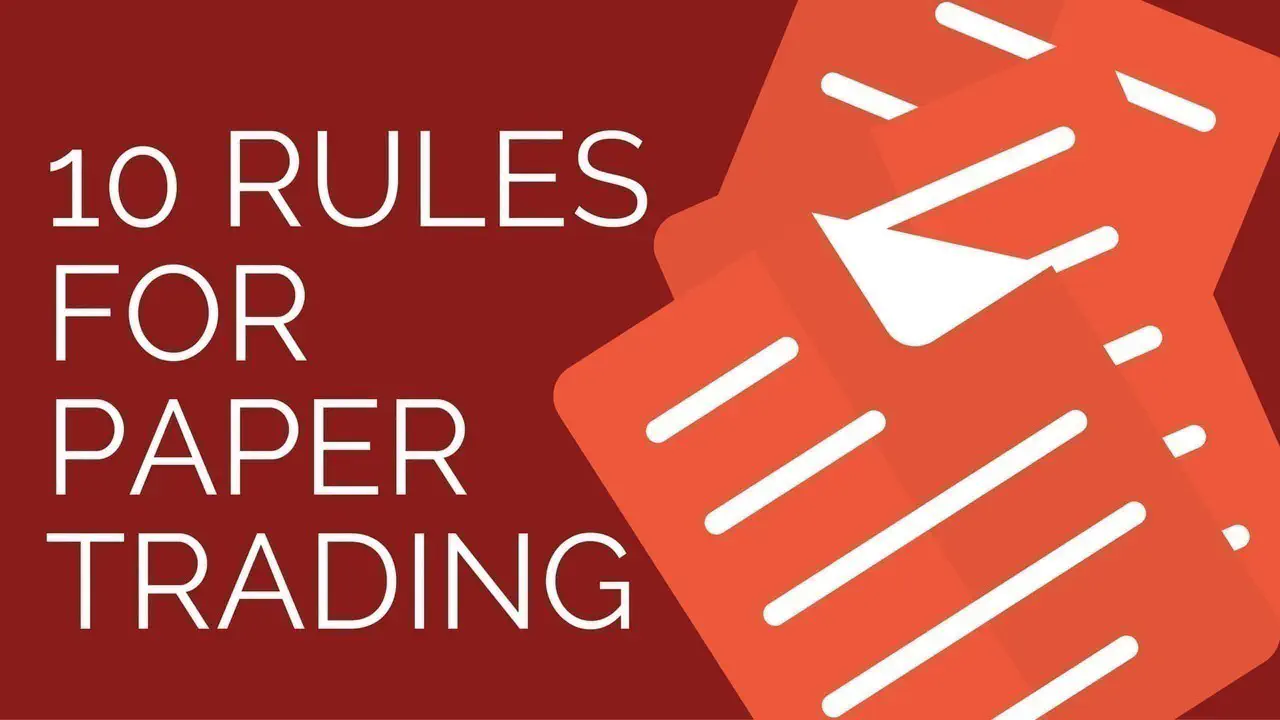Don’t Start Paper Trading Unless You Follow These 10 Rules
By Galen Woods ‐ 8 min read
Paper trading offers a way to learn without risk. But virtual trading can be unrealistic. Follow these 10 rules to ensure a realistic simulation

Have you considered paper trading as a way to learn about the markets risk-free?
Paper trading (or virtual trading) has many benefits. The most important one is to verify your trading edge without putting your money at risk. Most would agree that aspiring traders have much to gain from trading in simulation mode.
What you may not know is that paper trading might bring you more harm than good. This is because of several important differences between simulation and live trading. Even the best trading simulators are unable to replicate live trading with all its highs and lows.
Here are the drawbacks of paper trading from a few experienced traders…
Real money traders deal with all sorts of hidden costs from slippage to commissions.
Paper trading wouldn’t teach us one of the most important lessons needed for traders – how to control our emotions.
And once your money is at risk it is a different ball game. Emotions cloud judgment, as fear and greed become your enemies.
Now, these cons do not mean you should not paper trade as part of your trading education. Rather, it means that you need to be more cautious in your approach.
Don’t treat your paper trading account like a toy. Don’t trade irresponsibly just because you think it’s all just simulated.
Recognise that the way you paper trade has a big impact on your future trading performance.
Here are 10 rules you should follow if you plan on paper trading:
Create feelings of greed and fear in your paper trading by design
The key problem with paper trading is that you do not experience the same level of emotions as live trading. When emotions seep in, your trading will go awry.
Why don’t you feel the emotions of fear and greed when you trade in simulation mode?
This is because you don’t have your hard-earned cash on the line. You are not risking something you care about.
The three first rules are designed to compensate for this.
#1: “Earn” what you need to fund your live trading account
Should you fund your live trading account with $5k? $25k? $100K? Or just whatever you can afford?
New traders often decide how much to put in their live trading account based on how wealthy they are. But that’s not the only factor you should consider.
A more crucial factor is your trading skill. This means that a better trader, not a richer trader, has the right to trade a larger account.
Hence, your net paper profit shall determine the maximum you can place into a live account.
This will help you determine the goal for your paper trading exercise. “Earn” enough to fund your live trading account.
For instance, you want to fund your live trading account with $10k. You must first earn net profits of $10k in your virtual trading account.
For most aspiring traders, they are anxious to trade. Funding a live account and putting on real trades are what they yearn to do.
This first rule places their anxiety to trade against themselves. The aim is to create emotional turmoil as they paper trade, to put something they care about at risk.
#2: Set discipline goals
You must have a rule that states:
Take X number of trades according to the same trading plan.
You can only move on to trading live if you manage to take X trades with the same trading plan.
For the number X, the higher the better. 100 is a good number to start with.
If you violate your trading plan or change parts of it, you must reset the count of trades.
This rule is to ensure trading discipline and to verify your trading edge. It will also ensure that your virtual profits are not a result of luck. (No guarantee there though.)
#3: Never ever reset your paper trading account balance
This is a critical piece of the emotions puzzle.
Do not reset your paper trading account balance. Go into virtual debt if necessary.
If you do go into virtual debt, you must continue to paper trade to pay off your debts. You must also regain your virtual trading capital.
Only then, you can start earning paper profits that grant you the right to fund your live account.
The right to fund your live trading account means something to you. And you want to start live trading as soon as possible.
Hence, you will feel a need to make money in your virtual account. (Greed seeps in.)
At the same time, you know that you cannot reset your account and might even go into virtual debt. All these will affect how soon you can start trading live. (As you are eager to start trading live, you start to fear losing your virtual money.)
Follow the three rules above strictly. By doing so, you can create the feelings of greed and fear in your paper trading activity.

Ensure that your paper trading is realistic
Other than the issue of emotions, there are other important differences between paper and live trading.
Following the next four rules will help to create a realistic virtual trading process.
#4: Start with a realistic paper trading capital
Most trading simulators start you off with a high amount of default trading capital. While that might make you feel like a Monopoly winner, that is not realistic.
Remember that you are trading in simulation with the end goal of trading a live account.
Hence, you must consider your financial situation. Then, start with the virtual capital you can realistically put into your live account when the time comes.
#5: Account for slippage
Slippage is the difference between the price you expect and what you get. It’s a cost of trading.
For instance, you send in a market order to buy when the stock is at $50. However, your order is executed at $50.10. In this case, the slippage is $0.10.
It’s difficult to replicate the effects of slippage accurately. Some trading simulators have algorithms to do this but their accuracy is debatable.
A simple method to account for slippage is to deduct the bid-ask spread from your net profit for each trade.
Using a limit order might allow you to avoid slippage issues. But you might encounter the issue of non-execution. Your limit order might be executed by the simulator. However, a similar order in the real market might not have been executed.

#6: Count in your trading commissions
This is a simple rule. Check how much your broker charges and factor that into your trading performance.
If you are using your broker’s platform, most likely, the commission has been included.
#7: Use real-time market data
Many trading simulators, especially the free ones, delay their data feed. This is so that you cannot use their data for live trading using another platform.
Hence, you must ignore and completely avoid real-time news and price movement. If not, you are trading the past with knowledge of the future. Highly unrealistic.
This is why, if you can afford it, you should use real-time market data for your simulation trades.
As most data delays are within an hour, this rule is more pertinent for day traders. If you trade off daily charts, the data delay is not a big issue.
Learn all you can from your virtual trading experience
Never lose track of the main aim of paper trading: education.
You want to improve your trading plan as much as you can. Only then, you will feel confident putting real money on the line.
#8: Keep good trading records
Keep good trading records to learn from your trades.
If you manage to produce virtual profits, you want to know how you did it. If you ruin your paper account, you want to learn to avoid your mistakes.
Either way, you need good trading records.
#9: Future-proof your trading platform
To trade well, you must know how to use your trading platform effectively.
For instance, I know the keyboard shortcuts I need to draw chart objects like trend lines. They are useful for keeping track of intraday charts that move quickly. I also know how to set auto bracket order orders to take profit for my trades and to limit my risk.
Try to future-proof your trading platform by deciding on your eventual live trading platform. Then, find out if it allows paper trading. If it does, use it for your virtual trading.
This way, while simulating, you can improve both your trading skill and platform proficiency.
#10: Don’t join trading competitions
Most trading competitions do not use real money. Hence, the contest platform is usually a virtual trading platform.
As a result, many traders are introduced to trading simulators through trading contests.
However, trading contests do not offer a true learning experience. Trading contests have rules that are incompatible with your trading strategy and agenda. E.g. a fixed timeline and trading instrument.
Instead of wasting time to win on the organiser’s terms, you should focus on a strategy that works for you.
Moreover, trading is about overcoming yourself. It is not about winning the Market Wizards or the self-proclaimed trading guru in the trading forum.
Conclusion
Of course, live trading with real money is going to be different.
But if you follow the above rules, you won’t have to worry about your paper trading experience. You’ve done more than enough to mitigate the cons of virtual trading. And I am sure that your paper trading will provide great value despite the differences.
Always transit from paper trading to live trading with great caution.
Trade the smallest position size possible. You will experience live trading issues that you’ve not anticipated. And you will get a chance to smooth them out while taking on minimal risk.
Ultimately, the aim of paper trading is to make sure that you stand a good chance when you risk your hard-earned cash.
What other rules should you follow if you want to paper trade?